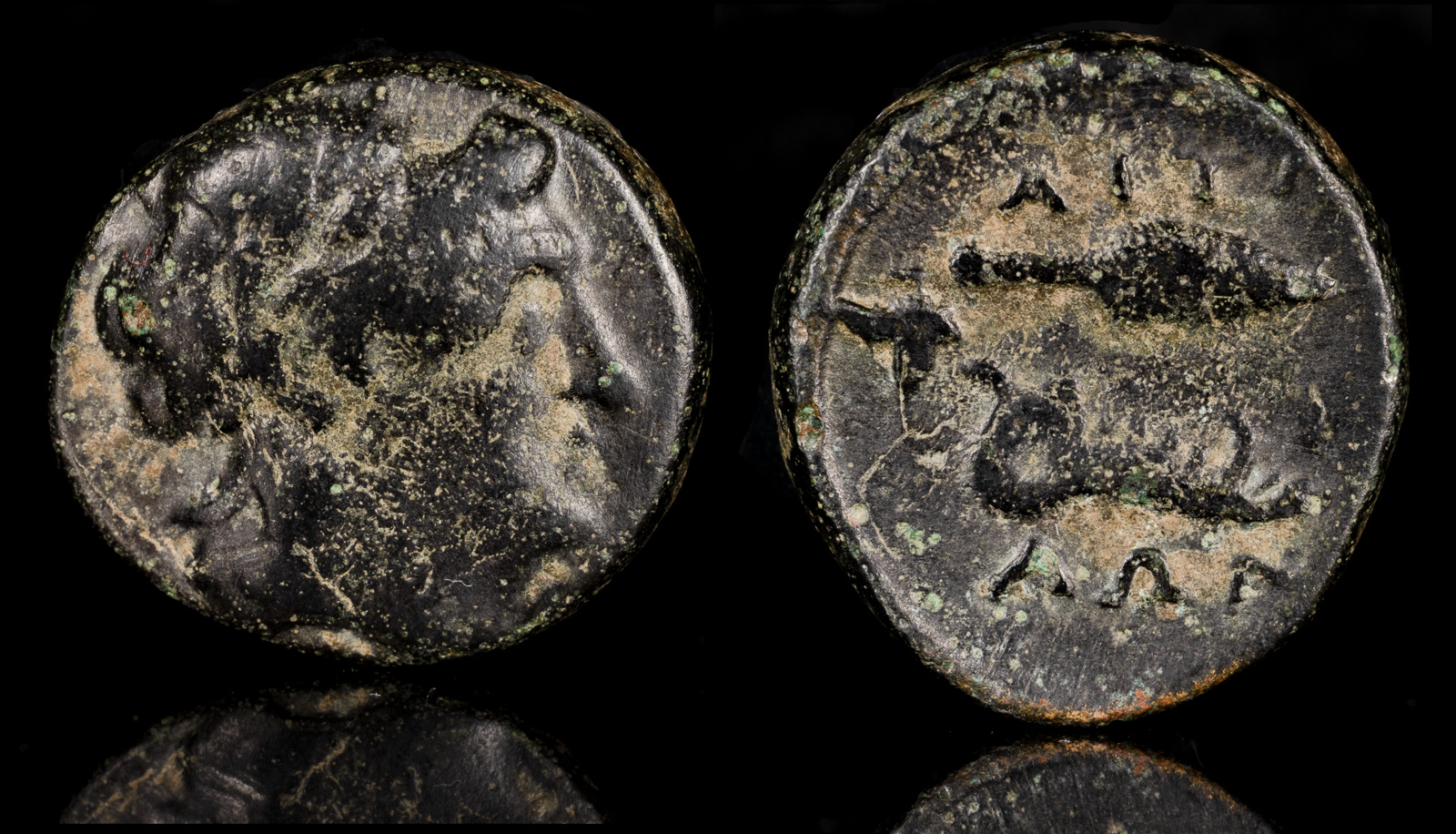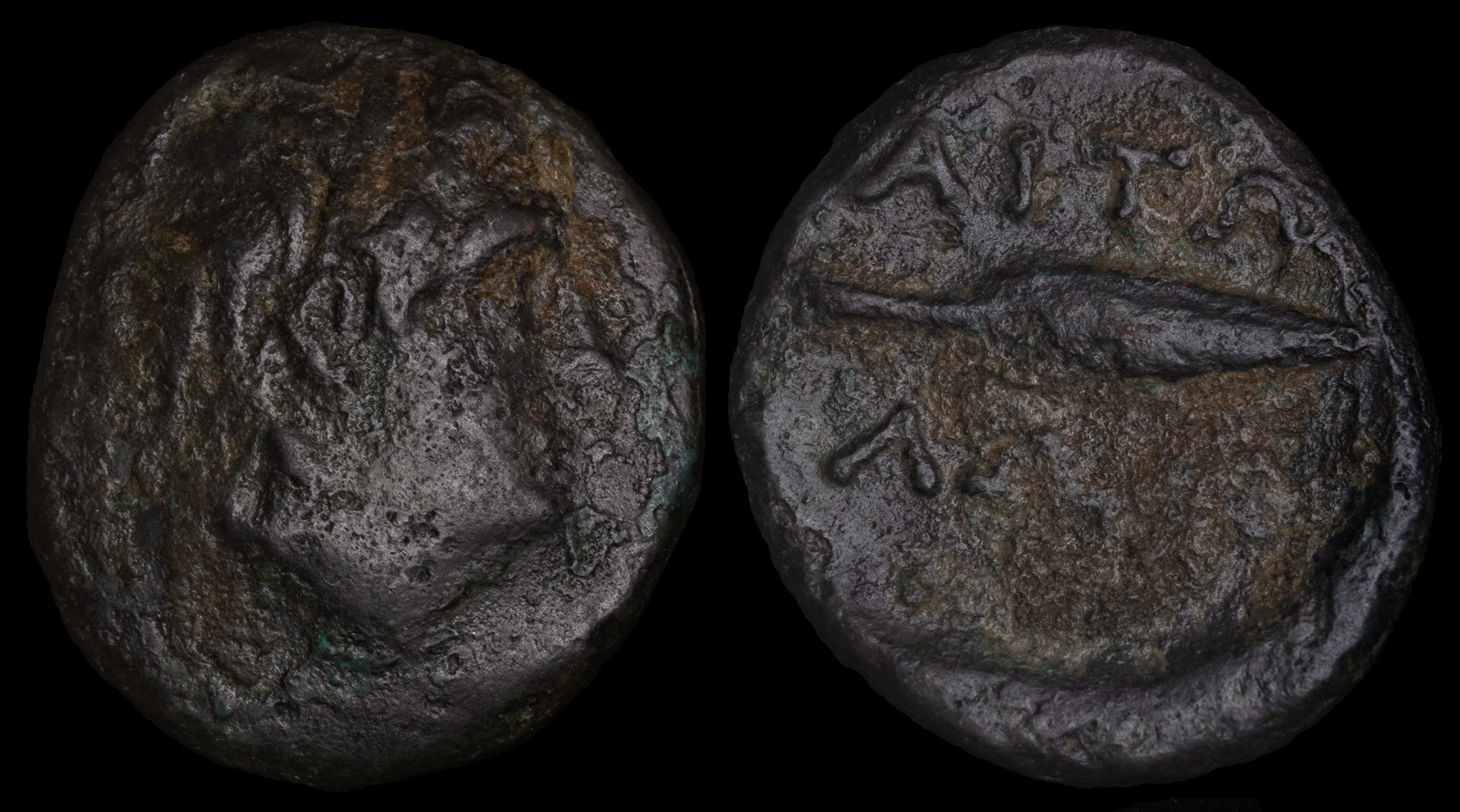
290-220 BCE
Ae 19mm 6.4g
Obv. Laureate head of Apollo right
Reverse: Spearhead above jawbone of Calydonian boar, grape bunch to left
Ex Bargain Bin Ancients
TheAetolian Leaguewas for some time a major player in Greece. However, many have never heard of it. The most likely answer is branding. While their ally against theGaulsAntigonos II Gonataswas a master of branding (after all, he had his MBA – Macedonian Business Administration), by which he minted coins with the image of Pan to recall the victory over theGauls the Aetolians were less imaginative. Therefore, most of us have forgotten them.
This is sad because their capital was Thermos. Yes. Now I’m not saying they were the first to get the copyright, but an army capable of carrying small containers that insulate liquids must have had some advantage, particularly in the hot summers of Greece.
Back in Alexander‘s and Philip‘s days, the Aetolians were perceived as ancient hicks. They were mostly farmers and herders and were considered backwards. That upset the Aetolians. They wanted to marauder around, annihilate cities, and cause general mayhem to their neighbors like the rest of the civilized world. Therefore, they banded together and did exactly that.
Their first major foray was shortly after the death of Alexander the Great in the Lamian War. Of all the Greeks, the Aetolians hated the Macedonians perhaps the most. They couldn’t stand all the posters and radio announcements that broadcast the latest Macedonian victory. So, when Alexander was out of the picture, they joined together withAthensin revolting againstAntipater

Aitolian League
290-220 BCE
Ae Chalkous 14.5mm 2.1g
Obv: Head of Apollo right
Rev: APO-LON above and below spearhead
BCD Aitolia 541
Together with the brilliant Athenian general Leosthenes, they were initially successful. At Thermopylae, they defeatedAntipaterand forced him to Lamia, where they put him under siege. What happened next, though, is puzzling.
The Aetolians announced that they had some business to take care of back home and abandoned their Athenian colleagues. What business did they have to take care of? Was it a business retreat? Did some of their goats get lonely? Like so many questions, the answers are lost in the dust of history.
What we do know is the Athenians didn’t fare so well without their allies. Leosthenes was killed in a freak foray,Antipaterescaped Lamia, then defeated the Athenians. While the Aetolians weren’t part of this defeat, it didn’t bode well for them, becauseAntipaterwas still pissed, and he now had one of Alexander‘s top generals in Krateros at his disposal.
Krateros envaded Aetolia, and rather than face a superior force head-on, the Aetolians resorted to guerrilla warfare with devastating effect. Unfortunately for them, Krateros was crafty.
He ceased chasing the Aetolians into the mountains, but occupied all of the lowland forts. Then winter came. Yes, Krateros knew the Starks. The goal was to freeze the Aetolians to death.
Krateros nearly accomplished this, until dissension elsewhere in Greece forcedAntipaterto come to an agreement with the Aetolians so he could recall Krateros to more important engagements. It was there that Krateros was killed in an “upset for the ages” by Eumenes, who previously was a clerk for Alexander the Great.
Athens attempts to invade Aetolia, but is forced back by the Aetolian League.
The Aetolian League receives Naopaktos from Philip II.
Heraia joins the Aetolian League.
Aetolian League occupies Delphi.
287 BCE
Demetrios I Poliorketes organizes the Fifth Sacred War against the Aetolian League’s occupation of Delphi, but is pushed out with the help of Pyrrhos.
Thebes allies itself with Lysimachos and the Aetolian League.
A Sixth Sacred War is led by King Arios of Sparta, in an effort to dislodge the Aetolian League from Delphi, but is defeated.
The Aetolian League obtains Herakleia Trachineia, giving them control over the pass of Thermopylae.
The Aetolian League along with Antigonos II Gonatas defeat an invasion of Gauls.
Stratos is taken by the Aetolian League.
The Aetolian League invades the Peloponnese and takes Pellene.
Orchomenos switches from the Aetolian League to the Achaian League.
The Aetolian League is attacked by Illyria.
The Aetolian League besieges Medeion, but are defeated by reinforcements sent by Demetrios II of Macedon.
216 BCE
The Lyttian War is fought between an alliance led by Knossos and one led by Polyrhenion. On the side of Knossos were Rhodes, the Aetolian League, and Kydonia. On the side of Polyrhenion were Lyttos, Macedon, and the Achaian League.
Kleitor repulses an attack by the Aetolian League.
Ambrakia is besieged by Philip V of Macedon, Phytia taken, and Metropolis is burned during the Social War between the Achaean League and the Aetolian League, of which Ambrakia is a member.
210 BCE
Aegina is briefly occupied by Aetolians.
Philip V persuades Kalchedon and Lysimachia to break from the Aetolian League.
197 BCE
The Aetolian League attempt to take Metropolis after Philip V retreats, but they are repulsed.
Aetolians are besieged in Herakleia Trachineia by Acilius Glabrio. After 21 days the town is taken.